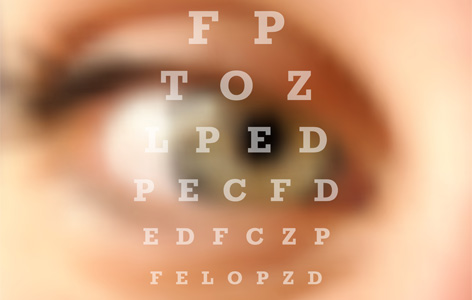Home page Description:
Initiation of eye movements found to be slower in individuals with lazy eye.
Posted On: July 13, 2016

Image Caption:
Lazy eye affects approximately one in three people and is the leading cause of blindness in one eye.
Lazy eye (amblyopia) is a condition in which the vision in one eye decreases due to inadequate use during childhood. It develops when the signals between the brain and the affected eye deteriorate, causing the brain to favour one eye. This can affect eye-hand coordination and limit a person’s ability to perform certain tasks like driving or reading.
Although a lot is known about the visual problems that stem from a lazy eye, it still remains unclear which eye movements are altered in individuals with the disease. To address this gap, Krembil Senior Scientist Dr. Agnes Wong conducted a study in which participants with or without a lazy eye were asked to visually track a moving target as quickly and accurately as possible.
The study revealed that compared to individuals with normal vision, those with a specific type of lazy eye (anisometropic amblyopia) took longer to start following the target with their eyes; however, the speed with which they continued to visually follow the target was similar to that measured in participants with normal vision.
Explains Dr. Wong, “To the best of our knowledge this is first study to compare this type of eye movement in people with lazy eye. Our findings could help researchers design new rehabilitation therapies for adults with a lazy eye who continue to experience visual problems despite treatment.”
This work was supported by the Canadian Institutes of Health Research, the Canada Foundation for Innovation, the John and Melinda Thompson Endowment Fund in Vision Neurosciences and the Department of Ophthalmology and Vision Sciences at The Hospital for Sick Children.
The initiation of smooth pursuit is delayed in anisometropic amblyopia. Raashid RA, Liu IZ, Blakeman A, Goltz HC, Wong AM. Investigative Opthalmology &Visual Science. doi: 10.1167/iovs.16-19126. 2016 April 1. [Pubmed abstract]
Although a lot is known about the visual problems that stem from a lazy eye, it still remains unclear which eye movements are altered in individuals with the disease. To address this gap, Krembil Senior Scientist Dr. Agnes Wong conducted a study in which participants with or without a lazy eye were asked to visually track a moving target as quickly and accurately as possible.
The study revealed that compared to individuals with normal vision, those with a specific type of lazy eye (anisometropic amblyopia) took longer to start following the target with their eyes; however, the speed with which they continued to visually follow the target was similar to that measured in participants with normal vision.
Explains Dr. Wong, “To the best of our knowledge this is first study to compare this type of eye movement in people with lazy eye. Our findings could help researchers design new rehabilitation therapies for adults with a lazy eye who continue to experience visual problems despite treatment.”
This work was supported by the Canadian Institutes of Health Research, the Canada Foundation for Innovation, the John and Melinda Thompson Endowment Fund in Vision Neurosciences and the Department of Ophthalmology and Vision Sciences at The Hospital for Sick Children.
The initiation of smooth pursuit is delayed in anisometropic amblyopia. Raashid RA, Liu IZ, Blakeman A, Goltz HC, Wong AM. Investigative Opthalmology &Visual Science. doi: 10.1167/iovs.16-19126. 2016 April 1. [Pubmed abstract]




